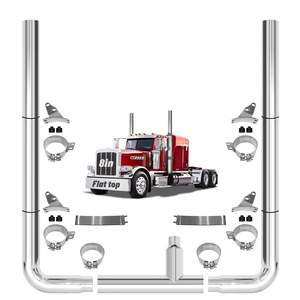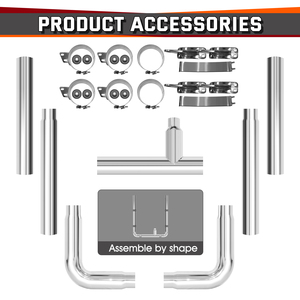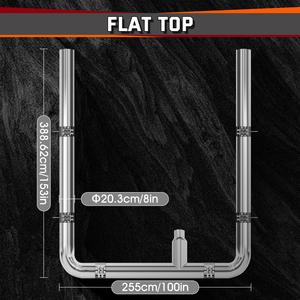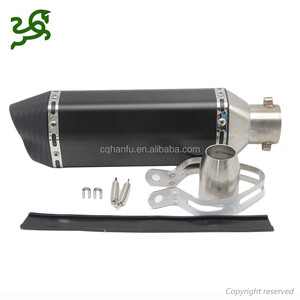(171 products available)











































































































































































































The Suzuki GSX-R is a sport bike known for its performance and sleek design. The exhaust system is critical to its operation, enhancing its performance and giving it a unique sound. Different types of exhaust systems exist, each with features and benefits.
Full exhaust systems
Full exhaust systems replace the stock exhaust and include headers, mid-pipes, and exhaust cans. These components work together to improve exhaust flow, reduce weight and improve the bike’s sound. The full exhaust system is popular with riders looking to improve their bike's performance. They are also suitable for those who want a sportier sound. When a full exhaust system is installed, the bike’s fuel system needs to be adjusted. This is to ensure the engine runs efficiently.
Slip-on exhaust systems
Slip-on exhaust systems are another type of exhaust GSXR 600. They involve replacing the stock muffler while the headers and mid-pipes are left untouched. This makes slip-on exhaust systems less expensive. They are also less complicated to install compared to full exhaust systems. Slip-on exhaust systems improve the bike’s sound and reduce weight. They also give a little performance boost. While no tuning is required after installing a slip-on exhaust system, getting the bike checked is recommended. This is to ensure it runs efficiently.
Cat delete exhaust systems
Cat delete exhaust systems involve removing the catalytic converter from the exhaust system. The catalytic converter is responsible for reducing harmful emissions from the bike. Removing it results in higher emissions. As a result, cat delete systems are illegal in many regions due to environmental regulations. Cat delete exhaust systems enhance performance. They do this by further improving exhaust flow. The removal of the catalytic converter also results in a more aggressive exhaust note.
Carbon fiber exhaust systems
Carbon fiber exhaust systems are designed for the Suzuki gsxr 750 exhaust. They are high-performance exhaust systems that offer weight savings. This is because carbon fiber is a lightweight material. These exhaust systems can improve the bike's performance by lowering the overall weight. Carbon fiber exhaust systems are also known for their unique appearance.
When looking for a motorcycle exhaust system, the Suzuki GSX-R series is one of the best choices. The bikes in this series have impressive exhaust notes that match their performance on the road. However, the exact sound and look of the exhaust will depend on the specific model of the bike. Here are the specifications and maintenance requirements of the exhaust GSXR.
As mentioned earlier, the specifications of the exhaust system will depend on the specific model of the motorcycle. However, here are the general specifications of the exhaust GSXR.
Material:
The exhaust system is made of durable and robust material to withstand the high temperatures and pressures of exhaust gasses. Stainless steel is a popular choice due to its corrosion resistance. Carbon fiber is another material used in some exhaust systems. It is lightweight and can give a bike a sporty aesthetic.
Sound level:
The Suzuki GSX-R exhaust system is designed to produce a sound level that is thrilling without being overly loud. Some models have a sound level adjustment feature, allowing riders to customize the sound to their preference.
Pipeline diameter:
The diameter of the exhaust pipes is carefully calibrated to balance exhaust flow and back pressure, optimizing engine performance. Depending on the model, the pipe diameter ranges from 38 to 50 mm.
Weight:
The exhaust system is designed to be lightweight, as reducing the overall weight of the motorcycle improves performance. The exhaust system of each GSXR series bike is designed to be as light as possible without compromising durability. For instance, the exhaust of the GSXR 1000 is 2.5 kg, while that of the GSXR 750 is 3.5 kg.
Maintaining the exhaust GSXR is crucial to ensure optimal performance and durability. Here are the maintenance requirements:
Visual inspection:
Regularly inspect the exhaust system for signs of wear, damage, or leaks. Carefully check for cracks, rust, or dents. Also, ensure there are no loose or missing bolts and clamps.
Cleaning:
Keep the exhaust system clean to maintain its appearance and performance. Use mild soap and water to clean the outer surface of the exhaust pipes regularly. Avoid using abrasive cleaners or materials that can scratch the chrome or coatings. Also, remove any dirt, debris, or bugs from the exhaust tips and pipes. Clean the exhaust heat shield to prevent rusting.
Tightening:
Periodically check all the bolts, clamps, and connections of the exhaust system to ensure they are properly tightened. Vibrations from the engine and exhaust can loosen these fasteners over time. Loose components can cause exhaust leaks, increased noise, and potential damage to the exhaust system.
Corrosion protection:
Apply a corrosion protection product to the stainless steel and aluminum components of the exhaust system. This can help prevent rust and corrosion, mainly if the motorcycle is exposed to moisture or road salt.
Compatibility
This includes ensuring that the exhaust system is compatible with the make and model of the GSXR motorcycle. Exhaust systems are designed for specific bike models, so it's essential to check compatibility to avoid fitting issues and ensure optimal performance enhancements.
Material
Consider the different materials used in exhaust gsxr 750. Stainless steel is a popular choice because of its corrosion resistance, durability, and affordability. Titanium is another option; it is lighter than other materials and provides superior heat resistance, making it suitable for high-performance bikes. Carbon fiber is used for its lightweight properties and modern aesthetics, but it may require more maintenance to prevent degradation from UV exposure.
Legal Compliance
When choosing an exhaust system, it's essential to consider the rules and regulations of the area regarding noise levels and emissions. Some exhaust systems are designed to be street legal, with features like catalytic converters to reduce emissions and comply with environmental standards. Before installing a new exhaust system, users should familiarize themselves with the local laws to avoid fines or penalties.
Maintenance
This involves selecting a gsxr exhaust system that is easy to maintain and clean. Some materials, like stainless steel, require minimal maintenance and can be easily cleaned to maintain their appearance. Carbon fiber may require more frequent cleaning to remove residue and prevent degradation. Consider the accessibility of exhaust system components for cleaning and maintenance tasks. Choosing an exhaust system with removable heat shields and accessible areas for cleaning can save time and effort in regular maintenance.
Performance Gains
This involves understanding the benefits of different exhaust systems. Full systems replace the stock header pipes and the muffler, resulting in significant weight savings and increased power. Slip-on mufflers are easier to install and more affordable, but they offer limited performance improvements compared to full systems. Removing the baffle from the exhaust can produce a louder sound and slightly improve airflow but requires careful consideration of noise regulations and potential damage to the exhaust.
Tuning
This involves selecting an exhaust system compatible with the motorcycle's tuning requirements for optimal performance. Full exhaust systems often require remapping the ECU for proper fuel and ignition timing adjustments to maximize power gains. Slip-on mufflers may not always need ECU remapping, but it can benefit performance in some cases. Consider the tuning options available for the selected exhaust system and whether additional components, such as a fuel controller or ECU flash, are necessary for optimal performance and reliability.
Here is a simple DIY guide for replacing the exhaust gsxr 600 or 750.
Preparation
Gather tools: A socket set, wrenches, and pliers are needed. Get a new exhaust system that fits the gsxr model. Ensure the bike is cool and parked on a level surface. Also, have a carbon gasket cleaner.
Removing the old exhaust
Start by loosening the clamps and bolts connecting the exhaust to the bike. These are usually located near the bike's foot pegs and under the rear tail. Use a socket wrench or ratchet to remove the bolts and carefully slide off the clamps. Take out the bolts connecting the exhaust pipes to the bike's frame. Use a wrench or socket to reach the bolts and use a torque wrench to avoid damaging the bike's frame. The bolts are usually located near the bike's engine and under the seat. The final step in removing the old exhaust is to disconnect any hangers or mounting points holding the exhaust in place. These can be located on the side stands or the swingarm.
Preparing the new exhaust
Assemble the new exhaust system by following the manufacturer's instructions. Make sure the carbon gsxr exhaust bike parts are clean and free of debris. This can be done by using a carbon gasket cleaner and a clean rag.
Installing the new exhaust
This involves reversing the steps taken when removing the old exhaust. First, the new exhaust pipes are connected to the bike's engine using new gaskets and bolts. Then, the system is secured with clamps and hung on the side stand and the swing arm.
Checking and testing
Once the new exhaust has been installed, start the bike to ensure there are no leaks or unusual noises. Take the bike for a short ride and then inspect the exhaust connections to ensure everything is still tight and secure.
Q1: What is the purpose of an exhaust system on a motorcycle?
A1: The exhaust system on a motorcycle, like on a Suzuki gsxr exhaust, has three main functions. One is to get rid of the exhaust gases made when fuel burns in the engine. Another is to make the bike run quieter. The last one is to help the gsxr exhaust pipes look nice.
Q2: What does a full exhaust system on a motorcycle include?
A2: A full exhaust system on a motorcycle has two main parts. One is the exhaust header, which includes the pipes that carry the gases away from the engine. The other is the exhaust slip-on, which is connected to the end of the headers and helps with the bike's sound and performance.
Q3: Why are aftermarket exhaust systems better?
A3: Aftermarket exhaust systems can offer a few advantages over standard ones. They might improve engine performance by making it breathe better. Many also use lighter materials, which can reduce the bike's overall weight. Perhaps the most noticeable difference is the changed sound, which many find more appealing. Additionally, some aftermarket exhausts can enhance the bike's appearance.
Q4: Why does the exhaust smoke from a motorcycle appear white?
A4: If a motorcycle exhaust shows white smoke, it likely has water vapor. This is normal when starting up on a cool day. However, if the white vapor persists, it could indicate coolant leaking into the engine, which requires prompt attention. Other colors, like black or blue, can signify different issues, such as running too rich (black) or oil burning (blue).